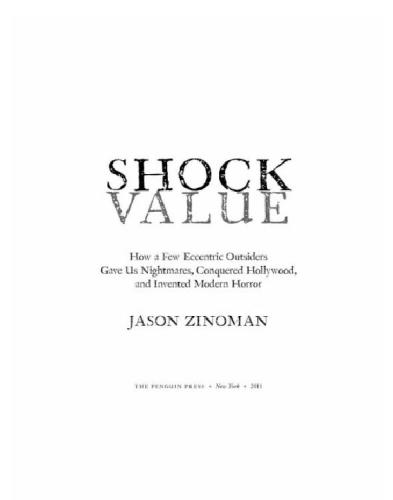
Shock Value
How a Few Eccentric Outsiders Gave Us Nightmares, Conquered Hollywood, and Invented Modern Horror
کتاب های مرتبط
- اطلاعات
- نقد و بررسی
- دیدگاه کاربران
نقد و بررسی

Starred review from August 8, 2011
New York Times critic Zinoman's illuminating book examines the period from 1968 to 1979 when a new breed of directors (including Wes Craven, John Carpenter, and George Romero) took a once mocked genre into the mainstream. In analyzing the transition from "Old" to "New" Horror, Zinoman suggests that all directors owe a debt to Alfred Hitchcock, who revolutionized the psychology of the serial killer plot, as well as those philosophers of fear, Edgar Allen Poe and H.P. Lovecraft. Zinoman writes with zeal, weaving copycat killers, celebrity stories, and the Manson family into his contextualization of The Texas Chainsaw Massacre, Carrie, and Halloween. He notes that Night of the Living Dead "did for horror what the Sex Pistols did for punk." Though in-depth director bios and discussion of the changing movie business are fascinating, Zinoman's shot-by-shot descriptions of groundbreaking films and championing of understated gems are even more impressive. This volume reveals just enough to satiate horror aficionados, while offering plenty for curious fright-seekers who want to explore the formative years of what's become a billion-dollar industry. This is the golden age of horrorâ"Welcome to a cracked world."

July 1, 2011
An entertaining history of the metamorphosis of the horror film during the 1970s from a cult genre to a major part of mainstream Hollywood.
Today's filmgoers may think nothing of going to the local multiplex to see the latest incarnation of the Saw franchise, but New York Times theater reporter Zinoman reminds us of a time when such fare was restricted to drive-ins, while "mainstream" horror consisted of cheesy Vincent Price movies or vampire films from Britain's Hammer studios. The change is attributed to a group of maverick writers and directors including Wes Craven, John Carpenter, Tobe Hooper and George Romero, makers of such films a Night of the Living Dead, The Last House on the Left, The Texas Chainsaw Massacre and Halloween, which created a new type of horror based on reality instead of fantasy. The author investigates the cultural conditions that made the "New Horror" possible, and Zinoman is particularly interested in the personal aspects of the genre, including the influence of the creators' family lives and the idea that the appeal of horror movies is closely tied to childhood experiences. The author deeply explores the transition from the grindhouse to the mainstream theater through such movies as Rosemary's Baby, Carrie and The Exorcist, as well as the commercialization of the genre into the sequel-producing monster of today. Zinoman sometimes stretches a bit with his psychoanalyses, and the narrative structure can be somewhat awkward, but the characters and stories behind the films are engaging enough to keep even casual readers involved. The author also includes interviews and first-person recollections with many of the participants, and there is no shortage of juicy gossip, notably the falling-out between Carpenter and his film-school partner and Alien creator Dan O'Bannon. Like many trailblazers, O'Bannon and others, including Hooper, often failed to profit from their influential work, and Zinoman argues that the promise of the New Horror remains largely unfulfilled.
An engrossing look at an important cultural moment and a valuable addition to the canon of popular film history.
(COPYRIGHT (2011) KIRKUS REVIEWS/NIELSEN BUSINESS MEDIA, INC. ALL RIGHTS RESERVED.)

May 1, 2011
The golden era of the "Old Horror" film featured such enduring classics as Dracula and Frankenstein, but they now seem as tame as buttermilk compared with the key films that have been produced during the so-called New Horror era beginning in the 1970s. These include such seminal American films as Rosemary's Baby, The Last House on the Left, Night of the Living Dead, and The Exorcist, many of which could be termed "gore fests." In a sometimes chatty, sometimes scattershot, but quite readable style, Zinoman, a theater critic and reporter for the New York Times, discusses in detail a few films and such pioneering genre directors as John Carpenter, George Romero, William Friedkin, and Wes Craven. They often defied aghast critics (and sometimes studio moguls and audiences as well) to present their view of a world gone mad. VERDICT Given the plethora of available books about horror films, including recent scholarly ones such as Kendall Phillips's Projected Fears and Thomas M. Sipos's Horror Film Aesthetics, this will appeal mostly to readers seeking a general overview.--Roy Liebman, Los Angeles P.L.
Copyright 2011 Library Journal, LLC Used with permission.

June 1, 2011
Between 1968 and 1976, all the films that redefined the horror movie were made: Night of the Living Dead, Rosemary's Baby, The Exorcist, Dark Star, The Last House on the Left, The Texas Chain Saw Massacre, and Carrie. In fluent reporter's prose lent urgency by personal fascination, Zinoman tells how their creators made those paradigm-shifters; how they became popular favorites, against long odds for two of them (Living Dead, Dark Star); and something about the subsequent careers of their creators who made further horror films (not all did), paying particular attention to the highly influential Halloween and Alien. The makers of the new horror took inspiration from suspense master Alfred Hitchcock, especially his Psycho, but resisted his persistence in the old horror habit of rationalizing evil; the newcomers preferred not to explain. Most determined to emulate the realism of Psycho, the new horror also largely dispensed with monsters, preferring unambiguously human malefactors. There are many good-bad and downright bad books about horror movies. Zinoman gives us the rare all-good book about them.(Reprinted with permission of Booklist, copyright 2011, American Library Association.)

























دیدگاه کاربران